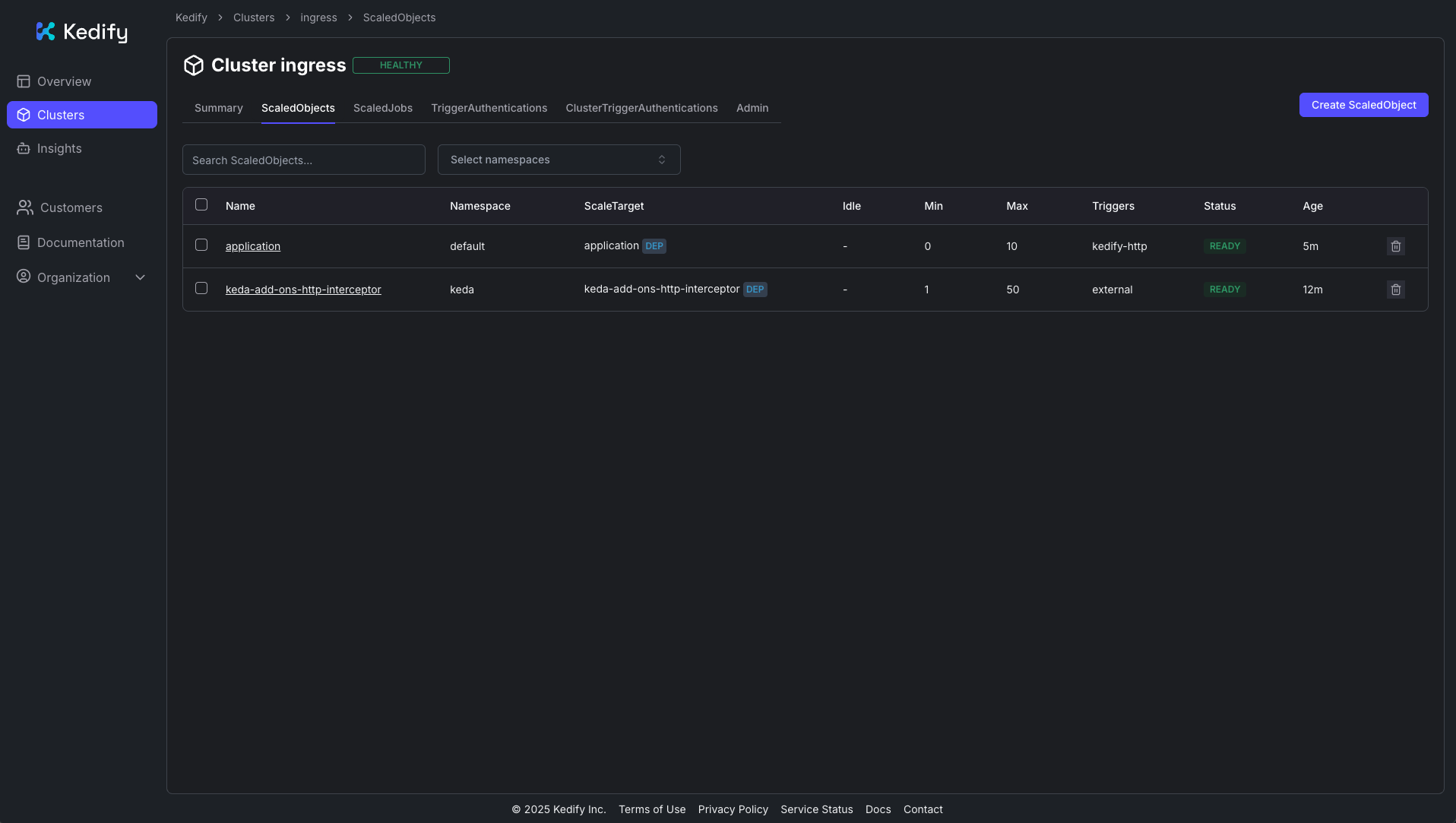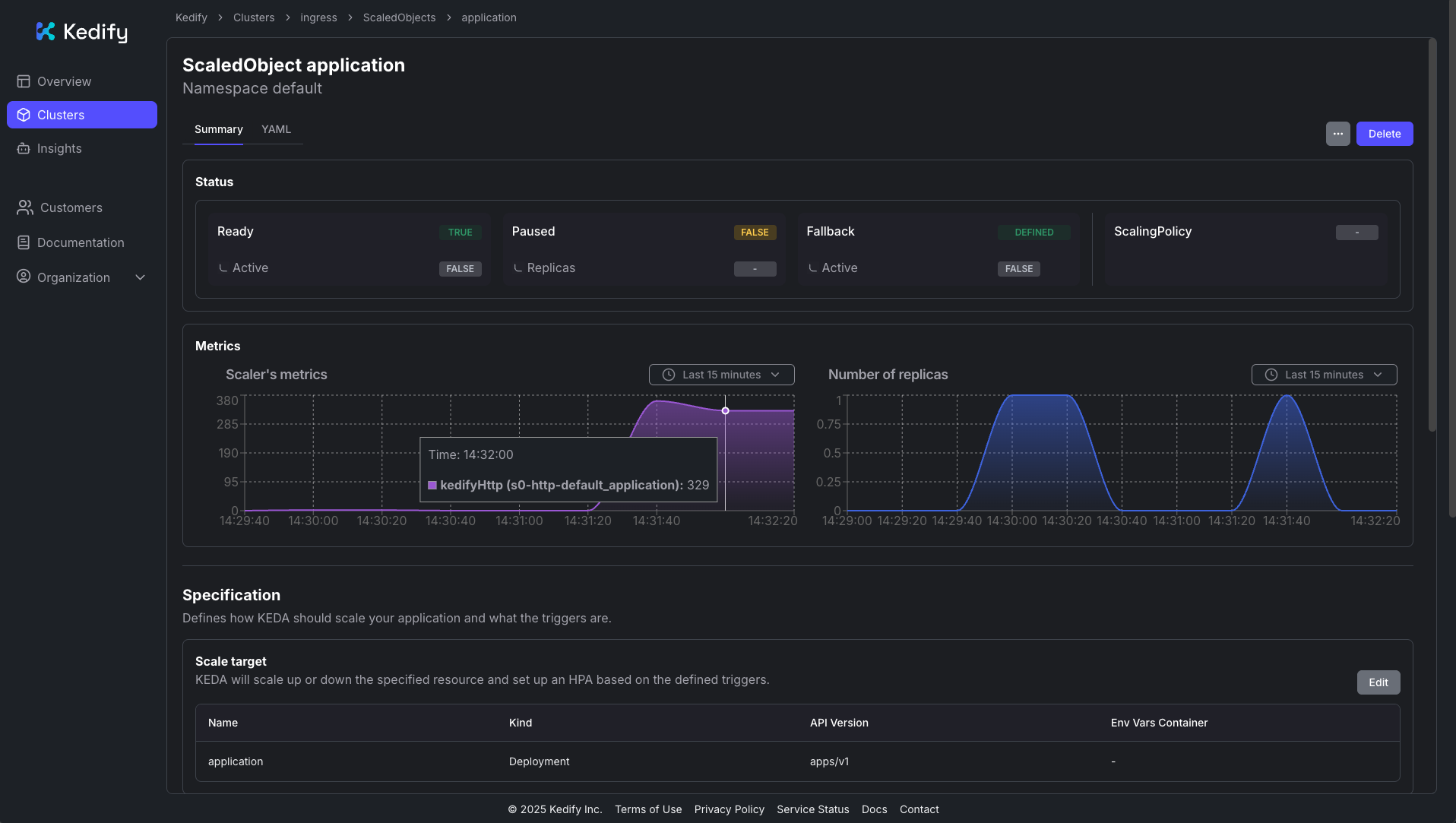HTTP Scaling with TLS for Ingress-Based Applications
This guide demonstrates how to scale applications exposed via Kubernetes Ingress with HTTPS enabled using the kedify-http scaler. It builds on standard HTTP-based autoscaling by adding TLS support for end-to-end encrypted workloads.
You’ll deploy a sample application configured with TLS, expose it via NGINX Ingress, and configure a ScaledObject that supports encrypted traffic. This works seamlessly with Kedify’s traffic autowiring system, enabling scaling to zero based on secure HTTP(S) traffic.
Architecture Overview
For TLS workloads using Ingress, Kedify intercepts traffic and collects encrypted traffic metrics without interfering with your TLS setup.
HTTPS Ingress -> kedify-proxy (with TLS support) -> Service -> Deployment
You can use any ingress controller that supports HTTPS. In this guide, we use NGINX Ingress with self-signed certificates.
Prerequisites
- A Kubernetes cluster (local or remote)
- The
kubectlCLI installed and configured - A connected cluster in the Kedify Dashboard
- openssl cli (for generating self-signed certs)
- hey for load testing
Step 1: Deploy a TLS-Enabled Application
Start by generating a self-signed TLS certificate and storing it as a Kubernetes secret:
openssl req -x509 -nodes -days 365 -newkey rsa:2048 \ -keyout tls.key -out tls.crt \ -subj "/CN=tls-demo.keda/O=tls-demo.keda" \ -addext "subjectAltName = DNS:tls-demo.keda"
kubectl create secret tls http-server-tls \ --cert=tls.crt --key=tls.keyNow deploy the application with TLS support:
apiVersion: apps/v1kind: Deploymentmetadata: name: http-server-tlsspec: replicas: 1 selector: matchLabels: app: http-server-tls template: metadata: labels: app: http-server-tls spec: containers: - name: http-server image: ghcr.io/kedify/sample-http-server:latest ports: - name: https containerPort: 8443 protocol: TCP env: - name: RESPONSE_DELAY value: '0.3' - name: TLS_ENABLED value: 'true' - name: TLS_CERT_FILE value: '/certs/tls.crt' - name: TLS_KEY_FILE value: '/certs/tls.key' volumeMounts: - name: tls-certs mountPath: /certs readOnly: true volumes: - name: tls-certs secret: secretName: http-server-tls---apiVersion: v1kind: Servicemetadata: name: http-server-tlsspec: ports: - name: https port: 443 targetPort: 8443 selector: app: http-server-tls- Deployment: A Go-based HTTP server configured to respond over HTTPS.
- Service: Exposes the HTTPS port to other cluster resources.
- Secret: Contains the TLS certificate and private key.
Apply the resources:
kubectl apply -f http-server-tls.yamlStep 2: Expose the Application with Ingress
Now expose your service to external traffic via HTTPS with NGINX:
apiVersion: networking.k8s.io/v1kind: Ingressmetadata: name: http-server-tls annotations: nginx.ingress.kubernetes.io/backend-protocol: 'HTTPS'spec: ingressClassName: nginx tls: - hosts: - tls-demo.keda secretName: http-server-tls rules: - host: tls-demo.keda http: paths: - path: / pathType: Prefix backend: service: name: http-server-tls port: number: 443Apply it:
kubectl apply -f http-server-tls-ingress.yaml- Ingress: Exposes the HTTPS endpoint to the outside world using NGINX.
backend-protocol: HTTPS: Ensures NGINX talks to the app using TLS internally.tls: Points to the TLS secret and hostname.
Step 3: Apply ScaledObject for TLS
Configure a ScaledObject to monitor HTTPS traffic on port 443:
apiVersion: keda.sh/v1alpha1kind: ScaledObjectmetadata: name: http-server-tlsspec: scaleTargetRef: apiVersion: apps/v1 kind: Deployment name: http-server-tls cooldownPeriod: 5 minReplicaCount: 0 maxReplicaCount: 10 fallback: failureThreshold: 2 replicas: 1 advanced: restoreToOriginalReplicaCount: true horizontalPodAutoscalerConfig: behavior: scaleDown: stabilizationWindowSeconds: 5 triggers: - type: kedify-http metadata: hosts: tls-demo.keda service: http-server-tls port: '443' scalingMetric: requestRate targetValue: '10' granularity: 1s window: 10s tlsSecretName: http-server-tlsApply it:
kubectl apply -f scaledobject-tls.yamltype(kedify-http): Specifies the Kedify HTTP scaler for monitoring HTTP traffic.metadata.hosts(application.keda): The hostname to monitor for traffic.metadata.pathPrefixes(/): The path prefix to monitor.metadata.service(application-service): The Kubernetes Service associated with the application.metadata.port(443): The port on the service to monitor.metadata.scalingMetric(requestRate): The metric used for scaling decisions.metadata.targetValue(1000): Target request rate; KEDA scales out when traffic meets or exceeds this value.metadata.granularity(1s): The time unit for the targetValue (requests per second).metadata.window(10s): Granularity at which the request rate is measured.metadata.trafficAutowire(ingress): Enables Kedify’s ingress autowiring feature.metadata.tlsSecretName(http-server-tls) References the Secret with the certificate, ensures KEDA can trust your TLS traffic.
You should see the ScaledObject in the Kedify Dashboard:

Step 4: Test HTTPS Autoscaling
To verify the server responds:
# If testing locally with k3d (if testing on a remote cluster, use the Ingress IP or domain)# we are also skipping self-signed cert verification via -kcurl -Ik -H "Host: tls-demo.keda" https://localhost:9443/You should receive a 200 OK with the server’s HTML:
HTTP/2 200date: Tue, 29 Apr 2025 12:47:02 GMTcontent-type: text/htmlcontent-length: 301x-keda-http-cold-start: truex-envoy-upstream-service-time: 3124strict-transport-security: max-age=31536000; includeSubDomainsTo trigger scaling:
# If testing locally with k3d (if testing on a remote cluster, use the Ingress IP or domain)hey -n 10000 -c 150 -host "tls-demo.keda" https://localhost:9443/Response time histogram: 0.301 [1] | 0.498 [9749] |■■■■■■■■■■■■■■■■■■■■■■■■■■■■■■■■■■■■■■■■ 0.695 [0] | 0.892 [0] | 1.090 [0] | 1.287 [0] | 1.484 [0] | 1.681 [53] | 1.878 [0] | 2.075 [53] | 2.272 [44] |In the Kedify Dashboard, you can also observe the traffic load and resulting scaling:

Next Steps
- This guide showed how to scale applications securely using HTTPS.
- You can extend this setup using production TLS certificates from
cert-manageror your preferred provider. - Explore the full HTTP Scaler documentation to tune scaling metrics, fallback behavior, and integration with other Ingress providers.